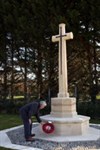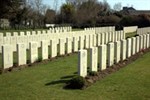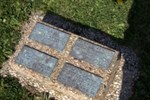 On a
recent trip to France Poynton Branch Chairman with his Wife visited
La Baule military cemetery to place a wreath on the
war memorial in commemoration of Operation Chariot, when on 28th
March 1942 HMS Campbeltown successfully rammed the
lock gates of the Normandie drydock in St.
Nazaire; putting the facility out of use and denying a repair
facility for the recently launched German battleship
Tirpitz.
On a
recent trip to France Poynton Branch Chairman with his Wife visited
La Baule military cemetery to place a wreath on the
war memorial in commemoration of Operation Chariot, when on 28th
March 1942 HMS Campbeltown successfully rammed the
lock gates of the Normandie drydock in St.
Nazaire; putting the facility out of use and denying a repair
facility for the recently launched German battleship
Tirpitz.
The cemetery in Escoublac-La-Baule is 13
kilometres west of St Nazaire situated at the mouth of the
La Loire river on France's western coast.
The cemetery began with the burial of 17 British soldiers killed
in the area
during 1940, 21 others who died in local hospitals, and
the area
during 1940, 21 others who died in local hospitals, and
a number of British servicemen whose
Throughout the occupation Louise Jaouen, a resident of
La Baule, dedicated all her time and energy to maintaining the
graves. With money collected
secretly from the generous local people she provided a
 cross for
every grave and a small monument, had hedges planted and employed a
permanent gardener to tend the grounds. Her devotion to this
work was honoured by the award of the King's Medal for service in
the cause of freedom. bodies were washed ashore after the
sinking of the troop ship "Lancastria" in the Bay of Biscay
cross for
every grave and a small monument, had hedges planted and employed a
permanent gardener to tend the grounds. Her devotion to this
work was honoured by the award of the King's Medal for service in
the cause of freedom. bodies were washed ashore after the
sinking of the troop ship "Lancastria" in the Bay of Biscay
on 17th June 1940. Subsequent burials include men killed in
the St. Nazaire raid in 1942, and airmen shot down in the
area. It now contains 325 commonwealth burials from the
Second World War 74 of which are unidentified. Three Polish
servicemen are also buried here and one man of the merchant Navy
whose death was not due to war service.
The tragic loss of the
Lancastria
On the 17th of June 1940, just two weeks after the Dunkirk
evacuations. the 16,000 ton Cunard liner
Lancastria lay 5 miles off St Nazaire on France's
western coast and embarked troops, RAF personnel, and civilian
refugees, including women and children, who were being evacuated
from France, which was then on the point of collapse. The
number on board may never be known, but almost certainly exceeded
6,000; some estimates put it as high as 9,000. The
Lancastria was attacked and hit by bombs from German
aircraft. The ship sank rapidly and, according to the
estimate of the Captain, only around 2,500 of those on board were
saved.
Owing to the scale of the tragedy, Winston Churchill forbade
publication of the news in the interests of public morale.
Since that time the disaster has never been fully recognised for
what it was - the greatest maritime disaster in Britain's
history. More people were killed on the Lancastria
than on the Titanic and Lusitania put
together.
Success of Operation Chariot - HMS
Campbeltown
It was on 28th March 1942 the successful British amphibious
attack took place on the heavily defended Normandie
drydock at St Nazaire in what then was German-occupied
France
Britain's Naval Intelligence Division first proposed a commando
raid on the dock in late 1941. When the German battleship
Tirpitz was declared operational in January 1942, the
Royal Navy and Royal Air Force were already drawing up plans to
attack her. Planners from Combined Operations Headquarters
were looking at potential scenarios if the Tirpitz escaped
the naval blockade and reached the Atlantic. They decided the
only port able to accommodate her was St Nazaire,
especially if, like the Bismarck, she was damaged en route
and needed to pull in for repairs. They concluded that if the
dock at St Nazaire was unavailable the Germans were
unlikely to risk sending Tirpitz into the Atlantic.
So at 01:34 on 28 March, four minutes later than planned, HMS
Campbeltown rammed the dock gate. The Commandos and
ship's crew came ashore under heavy German fire, and set about
demolishing the dock machinery. One hundred and sixty two of
the raiders were killed (64 commandos and 105 sailors) out of the
611 men in the attacking force. Of the survivors, 215 were
captured and 222 were evacuated by the surviving small craft.
A further five evaded capture and travelled overland through France
to Spain and then to Gibraltar.
The charges in HMS Campbeltown exploded at noon, an
hour and a half after the British had expected. Although the
ship had been searched by the Germans, the explosives had not been
detected. The explosion killed around 250 German soldiers and
French civilians, and demolished both the front half of the
destroyer and the 150 ton caisson of the drydock; with the rush of
water into the drydock washing the remains of the ship into
it. The St. Nazaire drydock was rendered unusable
for the rest of the war, and was not repaired until 1947.
German Military Cemetery,
Pornichet
 By comparison situated in nearby Pornichet
is a German Military Cemetery. It is very plain in appearance
and not tended to the level of Escoublac-La-Baule.
Graves are marked by rough pebble dashed plaques most representing
four soldiers.
By comparison situated in nearby Pornichet
is a German Military Cemetery. It is very plain in appearance
and not tended to the level of Escoublac-La-Baule.
Graves are marked by rough pebble dashed plaques most representing
four soldiers.
It was originally constructed by the Wehrmacht and
was
placed directly beside the civil cemetery of St.
Sebastien. To begin with 1,753 soldiers were laid to
rest but directly after the
war, the French extended this total to 2,672.
but directly after the
war, the French extended this total to 2,672.
After a treaty between the Germans and the French in 1955, it
was decided to extend the St. Sebastien cemetery in
Pornichet with the graves from nearby departments together
with several fieldgraves in the area. This increased the
total number of graves to the present total of 4,944.